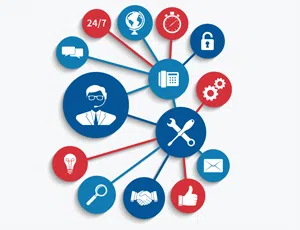When done correctly, a combination of variables will lead to your ultimate success — and it starts with getting your entire team on board.
Maximizing dispatch is a simple concept: Get the right technician to the right call for the benefit of our customer and the company. Most owners and managers feel like this idea isn’t worth their time, because their people already do that without being told. Some even go so far as to suggest that anyone not following that line of thinking should be fired.
And while I don’t disagree, I challenge you to consider that you might be a big part of the problem.
Right Technician, Right Call
The most obvious situation is a customer with a specific type of equipment that not everyone is qualified to repair. Sending a technician who cannot fix the problem is a waste of everyone’s time. Sadly, that is where most organizations stop their thinking, and that can be a costly mistake.
If you have a customer with a 15-year-old broken piece of equipment, and you send a technician to that call who can fix it but is scared by your replacement pricing, then you have made the wrong decision. Yes, we want to have repair be one of the options, but someone who doesn’t believe in your pricing will never recommend replacement.
Sometimes, a new unit is in the best interest of our customer. In that example, only looking at a technician’s ability to repair will most likely cost your customer aggravation and your company lost revenue.
A great dispatcher takes in more than just one factor when looking at a call and who to send. When done correctly, a combination of variables will lead to your ultimate success.
Get Everyone On Board
The first step is to get your entire team on board with the process. This means a meeting with all the field personnel, as well as applicable office staff, to explain and hash out your company dispatch policy.
When you make them a part of the process they are more likely to adapt to the change. This is the place to work out some of their anxiety. For example, it’s worth your time to explain that the closest person will not always get the closest call.
You need to make it clear that if the customer and the company are better served, you might have two technicians working next door to each other and you expect them to trust your judgment.
Be prepared for some discussion at that point. Don’t worry, it’s normal. They are resisting change and they are comfortable with how we’ve always done it.
Talk it through. An extra half hour of drive time is nothing if the customer is happy and the company makes money. Your whole team needs to understand and agree.
This will also help with anyone giving you trouble down the line. You tell them, “You were in that meeting, why do you insist on complaining when we all agreed that this was the best decision for our company?”
Your Dispatcher
Do you have the best person for this job doing the work? If the answer is yes, then the follow-up question is how do you know? The truth is more complex than you might think.
The first thing to look at is personality. If your dispatcher is a people pleaser and, more specifically, complains about people being mean or mad at them, then you have the wrong one.
When dispatching is done right, someone will always be upset with the person delivering the news, including technicians who must drive further than they wanted or work later than they planned, customers who need to be rescheduled because problems are taking longer than expected to fix and managers who have had to field phone calls from either of the first two groups.
Again, when dispatch is done well someone will always be upset, so great dispatchers let that slide knowing they are doing what is best for the customer base and the company. You might get some argument here, especially around rescheduling. Many people have trouble bumping a call that was locked in for some time in favor of something more severe that just came up.
Get your dispatchers thinking more like doctors. If you’re in the ER because you cut your hand and you think you might need a stitch or two, when someone with a gunshot wound comes in you’d never expect to go first. Along those same lines, if you have a follow-up appointment with your doctor, but they’re called in to surgery that day, you’d understand.
You might not be happy about the inconvenience, but you’d get over it — even if you don’t get over it, the person with the severe problem had a greater need for the doctor’s help.
If your people are bumping calls for the exact same call, then you are doing it wrong. But moving a couple maintenance calls to help a customer with a down unit is a no-brainer. This is more about training and interaction with you than natural ability, but back to my previous point: Your dispatcher cannot be put on permanent tilt when someone gets upset.
Details, Details, Details
Finally, your dispatcher should be detail oriented. There are a lot of moving parts in this position, including ordering, reschedules, equipment, assistance, etc., and you need someone who tracks things with ease. An unorganized person rarely thrives at dispatch. Take a hard look at your current person and make sure you have the right one for the job.
The next thing you need to think about as you try to maximize dispatch is the manager. Whether this is you, or someone who works with you, the key to great dispatching is management interaction. And before you pat yourself on the back, this doesn’t mean looking at the schedule, thinking everything is wrong, then re-arranging it the way you want it. If you’re moving calls around the board, then you’re not managing — you’re doing the work. Every time you change something on the schedule, you’re telling your dispatcher they’re wrong without teaching them what you consider a better decision. You might think the act of moving the call should be all the necessary instruction, but you’re incorrect. Moving the calls yourself trains your people to stop thinking about who runs what, because the manager is simply going to move them around anyway.
Learn How to Manage
The companies that complain about having to fix dispatch every morning always say that it keeps getting worse. That’s because they’re training their people that, no matter what they decide, it will be wrong. A better strategy is to have regularly scheduled interactions with dispatch.
The first one in the morning will probably be the longest, as you go through the day and have the dispatcher explain the board and how it is set. A great way to start is to have them identify the best calls and who is going to run them. If you don’t agree, resist the urge to immediately correct it and probe deeper into their thinking.
Sometimes your people know better than you do, but you’re so busy proving them wrong that you fail to listen to their ideas. Find out who they’re sending and why. Question the decisions that don’t seem perfect in a manner that doesn’t accuse or demean your dispatcher.
Instead of, “No that’s not right. Move this call here and have the other one run by Bob,” try, “I want to know more about sending Jim to that specific call.” And if their thinking is off, make them part of the correct action by teaching them what you want. Ask, “What do you think about Jim possibly running that other call? He is our best tech at informing customers about their choices and that unit is old.”
Talking them through your thinking is a much better teaching tool then just telling them to move the call because they were wrong, or worse yet, moving the call yourself with no explanation.
After the morning meeting, the next interaction should come sometime around lunch. This one will be quick and it sounds something like: “How is the day going so far? Is there anyone I need to call and congratulate or someone that needs some help? Anything come up since the last time we talked? Great, I’ll make those calls and follow up in a couple hours.”
Simple, but effective. You’re keeping a pulse on your day and the dispatcher feels supported, which is important.
Maybe your next interaction is the same as the last, but you ask how they’re doing toward their daily goal. If you don’t have one of those for your dispatcher, then you need to fix that immediately. Every dispatcher should have something to aim for every day to ensure they are getting the right tech to the right call.
When the manager and the dispatcher interact, progress to the goal should be a natural part of the conversation, especially during the later checks.
Near the end of the day is when the dispatcher needs the most help. The technicians are tired and want to go home, but the customers have scheduled these appointments because they work best for them. Also, your daily goal doesn’t change because your technicians are tired.
Think about how to improve your dispatching is the true secret to maximizing dispatch. Think about it. Look at it from all angles. Figure out how to get a little better each day.





